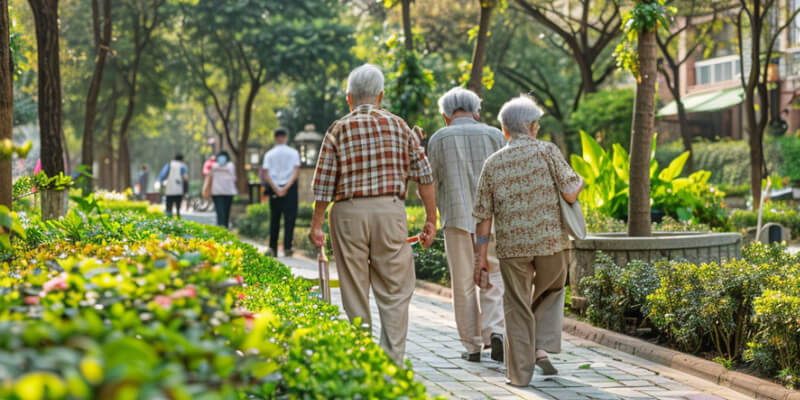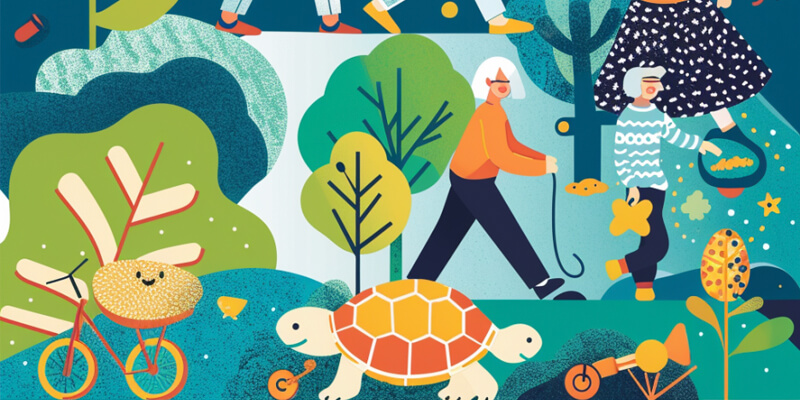Imagine living in a place where people often live over 100 years. This place, known as a ‘Blue Zone,’ has a high number of healthy, old people. Dan Buettner’s team has shown these areas to the world. They have a much higher life expectancy than the United States, where the average is about 77 years.
It’s amazing that living a long life in these areas isn’t just about genetics. It’s about their daily habits. Unlike much of the US, where 60% of people have a chronic disease, these zones follow a healthier lifestyle. The Blue Zones show us that with the right habits, living a long, healthy life is possible.
Key Takeaways
- The ‘Blue Zones’ serve as living evidence of regions where longevity signs are part of everyday life.
- Healthy aging is a tangible outcome of lifestyle choices prevalent among centenarian communities.
- Longevity research suggests implementable strategies can lead to a centenarian lifestyle.
- Adopting certain lifestyle behaviors from the Blue Zones can potentially raise life expectancies beyond the current US average.
- Chronic illnesses are less common in Blue Zones compared to the high prevalence seen in the general US adults.
- A synergy of diet, exercise, and community involvement are foundational to the longevity observed in Blue Zones.
Exploring Blue Zones: Secrets to a Centenarian Lifestyle
Blue Zones are known for their long-living residents. These places show us the possibility of living past 100 with good health and energy. They offer a peek into a long life. This suggests there’s a common secret to longevity found in different parts of the world.
What are Blue Zones?
Blue Zones are areas where people live longer than usual. They are like living labs. They show us ways to live a longer, healthier life. The name came from researchers. They used blue ink to circle these areas on maps.

The Five Blue Zones Defined
Each Blue Zone is unique but shares common values. Here’s a closer look:
| Location | Characteristic Traits |
|---|---|
| Sardinia, Italy | Known for a high population of centenarian men, Sardinia’s lifestyle includes a diet rich in legumes and emphasizes close familial ties and an active pastoral life. |
| Okinawa, Japan | Famed for its long-lived women, Okinawa boasts a low-calorie diet of primarily plant-based foods and a strong sense of community known as ‘moai’. |
| Loma Linda, California | Home to a community of Seventh-day Adventists, this Blue Zone is marked by a focus on spirituality, rest on the Sabbath, and a vegetarian diet. |
| Ikaria, Greece | This island’s slower pace of life, Mediterranean diet, and afternoon naps contribute to lower levels of stress and disease. |
| Nicoya, Costa Rica | Nicoyans enjoy strong social networks, a rich diet of tropical fruits, and a physical routine built into their daily lives, all playing a role in their long lifespan. |
People in these places like Sardinia, Okinawa, Loma Linda, Ikaria, and Nicoya connect deeply with their surroundings. This connection helps them live longer. These communities show us that our lifestyle choices are key to living a long life.
Genetic Markers and Longevity: Unraveling the Biological Clues
In centenarian research, there’s a key focus on how longevity genes impact health. Scientists studying people who live beyond 100 find certain metabolic profiles common among them. These profiles serve as clues, potentially guiding us to a longer life.

Studying metabolic data, researchers have identified biomarkers common in centenarians. This research has unveiled critical biochemical pathways. They could be essential in enhancing our lifespan. We’re now looking closer at how these biomarkers and longevity genes are linked.
| Longevity Biomarker | Common Level in General Population | Level in Centenarians |
|---|---|---|
| Glucose | 70-100 mg/dL | Significantly Lower |
| Uric Acid | 3.4-7.0 mg/dL | Reduced Levels |
| Creatinine | 0.72-1.25 mg/dL | Lower than Average |
These biomarkers show more than just numbers. They reflect a balance between our genes and how we live. Centenarian research often discusses this balance. It’s an exciting area that blends our biology and our choices.
Finally, learning from centenarians’ metabolic profiles and biomarkers is crucial. This information could guide us in making choices that support a longer, healthier life. It’s like having a map that shows us how to achieve remarkable longevity.
The Power 9: Lifestyle Habits of the World's Oldest Populations
Research on living a long, healthy life has discovered nine key habits. These habits come from the world’s oldest societies. They’re called the Power 9. These habits include moving every day, eating well, and having strong friendships. Together, they help people in Blue Zones live long and healthy lives.
Importance of Movement in Daily Life
In the world’s oldest cultures, moving every day is normal. Instead of gym workouts, they do things like garden, walk, or stretch. This way, staying healthy is simply a part of their daily lives.
Eating Wisely: The 80% Rule and Diet
Eating right is very important for living a long time. In Blue Zones, people mostly eat plants. They stop eating when they’re 80% full. This helps them avoid eating too much. It’s also good for our planet.
Community and Social Engagement
Being close to others is also key for a long life. Strong connections with family and friends are essential. These relationships give emotional support and keep everyone’s healthy habits on track.
The Power 9 habits are simple but powerful. They mix moving, eating well, and having friends. Following these habits can help us live longer. They show us how wisdom from the oldest people can guide us toward a long, healthy life.
Implementing Longevity Strategies: Realistic Changes for Healthier Living
Making changes for a longer life doesn’t have to be hard. Instead, it’s about slowly adopting good health habits. Getting advice from a wellness dietitian or using trusted health info can help a lot. What’s important is to find fun in the process of becoming healthier. Small choices, like taking stairs instead of elevators or eating more veggies, add up. They build a great foundation for long life, just like how people in Blue Zones live.
For a better future, add simple daily exercises that fit your life. Try walking around your neighborhood, dancing, or gardening. These activities should be fun and easy to keep doing. Being active and eating lots of plants help you live longer. Think of every healthy meal as a step towards more energy. This is what folks in Blue Zones do for their health.
Also, it’s vital to handle stress well and build strong friendships. Ways to manage stress include meditation, yoga, and thinking positive. Joining local events and having close friends make life richer. This builds a purposeful and connected life. By copying the community and support found in long-living areas, we can improve our health and longer life chances.
From the Author:
While the science behind longevity is fascinating, the true magic of the Blue Zones lies in their simplicity. Their example showcases that extraordinary longevity isn’t solely about cutting-edge therapies or genetic luck – it’s about embracing lifestyle habits that support our bodies and minds day after day.
Beyond the Power 9
The Power 9 provides a fantastic foundation, but I want to share some additional insights from my research that didn’t make it into the main article:
- The Microbiome Connection: Gut health is emerging as a crucial factor in longevity. Blue Zone populations often consume fermented foods and prebiotics, nurturing beneficial gut bacteria which can influence immunity, inflammation, and even mood.
- Circadian Rhythm’s Role: Aligning our sleep-wake cycles with natural light patterns is crucial for optimal health. Blue Zone communities prioritize sleep and often enjoy midday rests, which may help explain their lower rates of chronic disease.
- Nature’s Power: Spending time in nature has profound effects on stress reduction and mental well-being. Blue Zones are often characterized by accessible green spaces, emphasizing our connection to the natural world.
Small Steps, Big Impact
Implementing these practices doesn’t require relocating to a remote island. Here’s how to integrate Blue Zone wisdom into your everyday life:
- Go Wild with Food: Experiment with fermented foods like yogurt, kimchi, and sauerkraut. Include prebiotic-rich sources like onions, garlic, and whole grains.
- Sync with the Sun: Aim for natural light exposure in the morning and limit screens in the evening for better sleep. Consider a short midday nap if your schedule allows.
- Nurture Your Tribe: Prioritize meaningful connections with friends and family. Explore local groups or online communities that share your values and interests.
- Embrace the Outdoors: Take walks in parks, schedule a weekend hike, or simply enjoy a meal on your balcony. Even small doses of nature can be rejuvenating.
Remember, longevity isn’t about perfection; it’s about progress. Every mindful meal, every nature walk, and every genuine connection brings you closer to a longer, more vibrant life. The Blue Zones offer a blueprint – now it’s our turn to write our own longevity story.
FAQ
What are some common longevity signs to look for?
Look for signs like keeping a healthy weight and having stable metabolic levels. Low blood pressure and being active are keys too. Having lots of friends and a love for life matters as well. So does continuing to learn and have hobbies.
What exactly are Blue Zones and why are they important to longevity research?
Blue Zones are areas where people live very long and healthy lives, often over 100 years. They are important because they show the lifestyle, diet, and community aspects that lead to a longer life. They also show how to reduce chronic diseases.
Can you define the five Blue Zones and highlight their key longevity characteristics?
The five Blue Zones are Sardinia, Italy; Okinawa, Japan; Loma Linda, California, USA; Ikaria, Greece; and Nicoya, Costa Rica. They share traits like close family ties, eating mostly plants, staying active, and having a purpose in life.
Are longevity genes the only factor in living a longer life?
Genetics do play a role in how long we live, but they’re not everything. Lifestyle, where you live, your diet, and your friends also impact longevity. Studies of very old people show it’s a mix of good genes, healthy living, and strong support networks.
What does the Power 9 encompass in promoting a long life?
The Power 9 means nine habits from the oldest people around the world. These include moving around every day, having a purpose, lowering stress, and not eating too much. Eating well, a little alcohol, taking part in faith, putting family first, and being social also count.
How can implementing small changes enhance my potential for a longer, healthier life?
Small steps like moving more, eating vegetables and fruits, making friends, and handling stress can help you live longer. These changes bring big health rewards. They should fit what you can do and like.
What role does a wellness dietitian play in longevity?
A wellness dietitian gives you personalized advice on eating for a long, healthy life. They show you how to switch to eating habits that last. This helps you live longer and avoid sickness.





